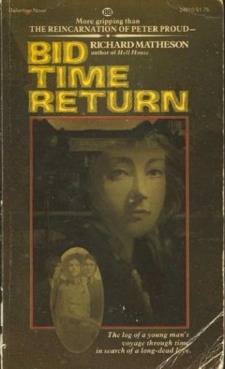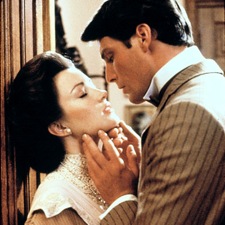Every Tuesday, Matthew R. Bradley takes us through the career of Richard Matheson. Catch up with the series through the Richard Matheson—Storyteller index.
The same year Matheson petrified viewers with one woman pursued by an unstoppable Zuni fetish doll in Trilogy of Terror (1975), he published the story of another who was the subject of a pursuit much more benign but, in its own way, just as relentless. Bid Time Return was his first novel since Hell House (1971), and along with its successor, What Dreams May Come (1978), could not have represented a starker contrast. These “two novels of love and fantasy” (as they were dubbed in an omnibus reissue), both of which take their titles from Shakespeare, earned the ever-varied author an entirely new audience…along with some dismissive reviews from critics unwilling to accept this departure from the terror and suspense to which they were accustomed.
Available in a handsome Tor edition—complete with a reading group guide by yours truly—Bid Time Return tells of terminally ill television writer Richard Collier, who decides to travel while writing a book about his last months of life, and impulsively stops at the Coronado Hotel outside San Diego. There, he sees and becomes obsessed with a portrait of turn-of-the-century actress Elise McKenna, improbably falling for a woman who has been dead for more than a decade, and projects himself back in time through sheer force of will to find her. Their romance in 1896 is hampered by her possessive manager, William Fawcett Robinson, but even after they overcome that obstacle, time itself proves to be an even more insurmountable one standing between them.
The novel was inspired by a visit to the opera house in Virginia City, Nevada, where Matheson saw a photo of actress Maude Adams, famed for J.M. Barrie’s Peter Pan, and wondered what would happen if its pull were strong enough to draw a man back through time. Many have noted its similarity to the work of Jack Finney, best known for the oft-filmed The Body Snatchers and his time-travel romance Time and Again, a similarity that Matheson hastens to acknowledge. For Dan Curtis, he had adapted Finney’s “The Love Letter” and “Second Chance” as an unproduced script for the abortive Dead of Night series and a segment of Dead of Night (1977), respectively; he paid his friend tribute with the character “Professor Finney” in the film of Bid Time Return.
 Retitled Somewhere in Time (1980), for fear that audiences would think it was Bed Time Return (no, I’m not making this up), the film was set in motion in January 1976 when Stephen Simon—then known as Stephen Deutsch after his stepfather, director Armand Deutsch—read the novel. Redoubling his efforts to break into Hollywood so that he could produce the screen version, he was hired as an assistant to producer Ray Stark just one month later, and immediately arranged a handshake deal with Matheson to secure the rights. Despite doubts about the book’s commercial potential, Universal owed director Jeannot Szwarc, a veteran of Matheson’s 1971 Night Gallery segment “Big Surprise,” a big favor for replacing John D. Hancock and salvaging Jaws 2 (1978).
Retitled Somewhere in Time (1980), for fear that audiences would think it was Bed Time Return (no, I’m not making this up), the film was set in motion in January 1976 when Stephen Simon—then known as Stephen Deutsch after his stepfather, director Armand Deutsch—read the novel. Redoubling his efforts to break into Hollywood so that he could produce the screen version, he was hired as an assistant to producer Ray Stark just one month later, and immediately arranged a handshake deal with Matheson to secure the rights. Despite doubts about the book’s commercial potential, Universal owed director Jeannot Szwarc, a veteran of Matheson’s 1971 Night Gallery segment “Big Surprise,” a big favor for replacing John D. Hancock and salvaging Jaws 2 (1978).
Matheson made several alterations in adapting the novel: Richard is now no longer terminally ill but a playwright whose trip is motivated by writer’s block, and the period scenes were updated to 1912, allowing for the addition of Arthur (Bill Erwin), an elderly hotel bellman linking past and present. Other new characters include Finney (George Voskovec), the source of Richard’s time-travel technique, and theatrical historian Laura Roberts (Teresa Wright), who provides much of the exposition regarding Elise’s life and career. He also introduced an antique watch presented to Richard by the older Elise the night of her death, which he in turn passes to the young Elise in 1912, thus creating a time paradox that the filmmakers ignored in favor of its cyclical resonance.
Against the advice of his representatives, Christopher Reeve turned down several better-paying gigs to play Collier, his first role since catapulting to stardom in Superman (1978), and felt an immediate affinity for his leading lady, Jane Seymour. A memorable Bond girl in Live and Let Die (1973), Seymour had appeared in the NBC miniseries Captain and the Kings (1976), with none other than Richard Matheson as President Garfield, and Christopher Plummer co-starred as W.F. Robinson, based on theatrical entrepreneur Charles Frohman. The setting of Grand Hotel, located on Michigan’s Mackinac Island, was selected after the Coronado (seen as “Mansfield House” on Ghost Story, for which Matheson wrote the pilot) was deemed too modern-looking.
Another key element was the film’s lushly romantic score by Bond mainstay John Barry, a friend of Seymour’s who took the job despite its being outside his usual price range, and wrote it amidst the pain of losing both parents several weeks apart. In the novel, Matheson refers to the work of his favorite composer, Gustav Mahler, but Barry’s bestselling score incorporated a piece that the filmmakers also used as a “bridge across time,” Rachmaninoff’s Rhapsody on a Theme of Paganini (Opus 43, Variation XVIII). Himself a sometime composer and lyricist, Matheson has even written an unfinished symphony in the style of Mahler, as well as the lyrics for a pair of songs recorded by Perry Como in the 1980s, “I Wish It Could Be Christmas Forever” and “Do You Remember Me.”
Instead of releasing the film gradually and allowing it to build word of mouth, Universal unwisely gave it a wide release in 800 theaters, further hampered by an actors’ strike that prohibited the stars from promoting it. Although it later earned an Oscar nomination for Costume Design and a Golden Globe nomination for Best Original Score, it received frequently hostile reviews, with Reeve—who acknowledged that he may have let too much of his Clark Kent characterization creep in—singled out for particular criticism. And yet, despite its inauspicious initial reception, Somewhere in Time gained a second life through showings on cable television and the sale of its phenomenally popular soundtrack, and in the thirty years since it was released, it has become a quintessential cult movie.
One of only three fan clubs devoted to a single movie, the International Network of Somewhere in Time Enthusiasts (INSITE) publishes an elegant quarterly journal—also called INSITE—that has more than 1,000 subscribers. INSITE helped Reeve get a star on Hollywood’s Walk of Fame, while each October, the anniversary of the film’s release, a Somewhere in Time Weekend is held at Grand Hotel, attended by fans in period costume and members of the cast and crew. John Shirley’s sequel, “Two Shots from Fly’s Photo Gallery,” can be found in Christopher Conlon’s He Is Legend tribute anthology, and Matheson’s long-cherished dream of a Broadway musical version appears to be on track, with a book written by Matheson and producer Ken Davenport and a score by Leslie Arden.
Matthew R. Bradley is the author of Richard Matheson on Screen, now in its second printing, and the co-editor—with Stanley Wiater and Paul Stuve—of The Richard Matheson Companion (Gauntlet, 2008), revised and updated as The Twilight and Other Zones: The Dark Worlds of Richard Matheson (Citadel, 2009). Check out his blog, Bradley on Film.










